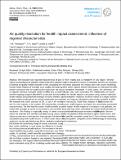Air quality resolution for health impact assessment: influence of regional characteristics
Author(s)
Thompson, T. M.; Saari, Rebecca Kaarina; Selin, Noelle E
DownloadThompson-2014-Air quality resoluti.pdf (1.207Mb)
PUBLISHER_CC
Publisher with Creative Commons License
Creative Commons Attribution
Terms of use
Metadata
Show full item recordAbstract
We evaluate how regional characteristics of population and background pollution might impact the selection of optimal air quality model resolution when calculating the human health impacts of changes to air quality. Using an approach consistent with air quality policy evaluation, we use a regional chemical transport model (CAMx) and a health benefit mapping program (BenMAP) to calculate the human health impacts associated with changes in ozone and fine particulate matter resulting from an emission reduction scenario. We evaluate this same scenario at 36, 12 and 4 km resolution for nine regions in the eastern US representing varied characteristics. We find that the human health benefits associated with changes in ozone concentrations are sensitive to resolution. This finding is especially strong in urban areas where we estimate that benefits calculated using coarse resolution results are on average two times greater than benefits calculated using finer scale results. In three urban areas we analyzed, results calculated using 36 km resolution modeling fell outside the uncertainty range of results calculated using finer scale modeling. In rural areas the influence of resolution is less pronounced with only an 8% increase in the estimated health impacts when using 36 km resolution over finer scales. In contrast, health benefits associated with changes in PM[subscript 2.5] concentrations were not sensitive to resolution and did not follow a pattern based on any regional characteristics evaluated. The largest difference between the health impacts estimated using 36 km modeling results and either 12 or 4 km results was at most ±10% in any region. Several regions showed increases in estimated benefits as resolution increased (opposite the impact seen with ozone modeling), while some regions showed decreases in estimated benefits as resolution increased. In both cases, the dominant contribution was from secondary PM. Additionally, we found that the health impacts calculated using several individual concentration–response functions varied by a larger amount than the impacts calculated using results modeled at different resolutions. Given that changes in PM[subscript 2.5] dominate the human health impacts, and given the uncertainty associated with human health response to changes in air pollution, we conclude that, when estimating the human health benefits associated with decreases in ozone and PM[subscript 2.5] together, the benefits calculated at 36 km resolution agree, within errors, with the benefits calculated using fine (12 km or finer) resolution modeling when using the current methodology for assessing policy decisions.
Date issued
2014-01Department
Massachusetts Institute of Technology. Department of Earth, Atmospheric, and Planetary Sciences; Massachusetts Institute of Technology. Engineering Systems Division; Massachusetts Institute of Technology. Joint Program on the Science & Policy of Global ChangeJournal
Atmospheric Chemistry and Physics
Publisher
Copernicus GmbH
Citation
Thompson, T. M., R. K. Saari, and N. E. Selin. “Air Quality Resolution for Health Impact Assessment: Influence of Regional Characteristics.” Atmospheric Chemistry and Physics 14, no. 2 (January 28, 2014): 969–978.
Version: Final published version
ISSN
1680-7324
1680-7316